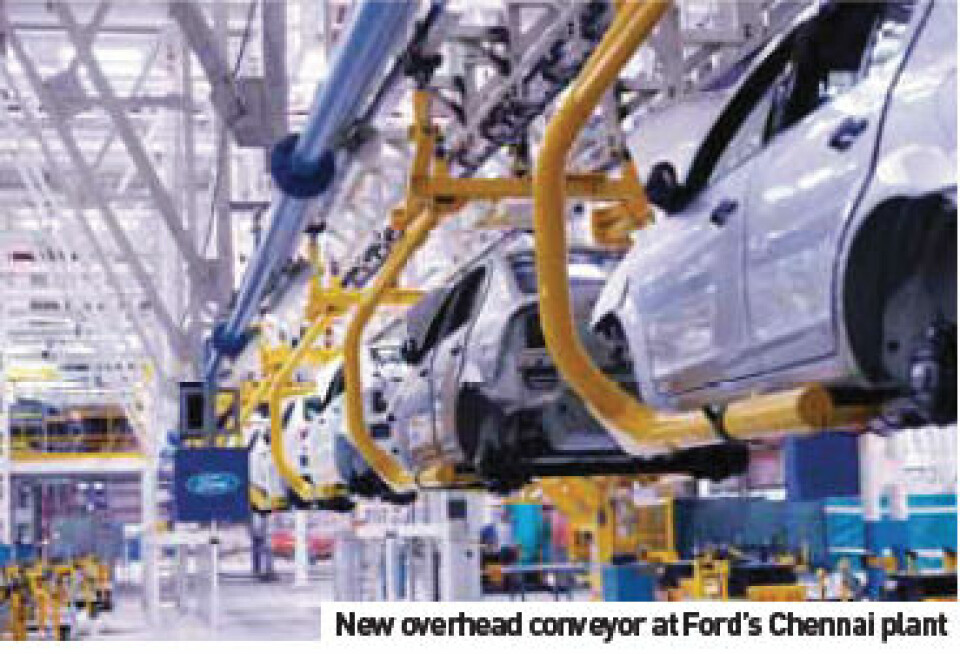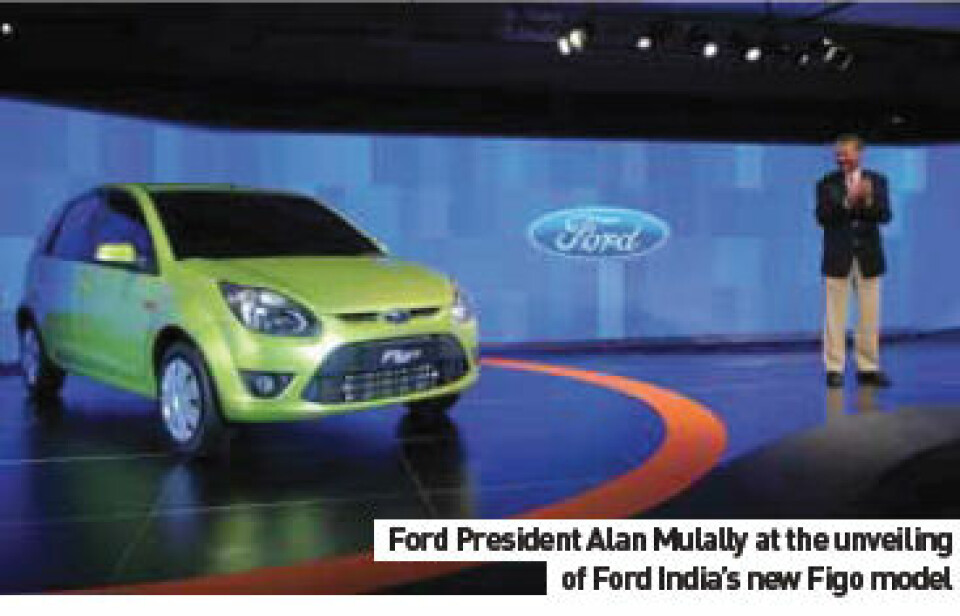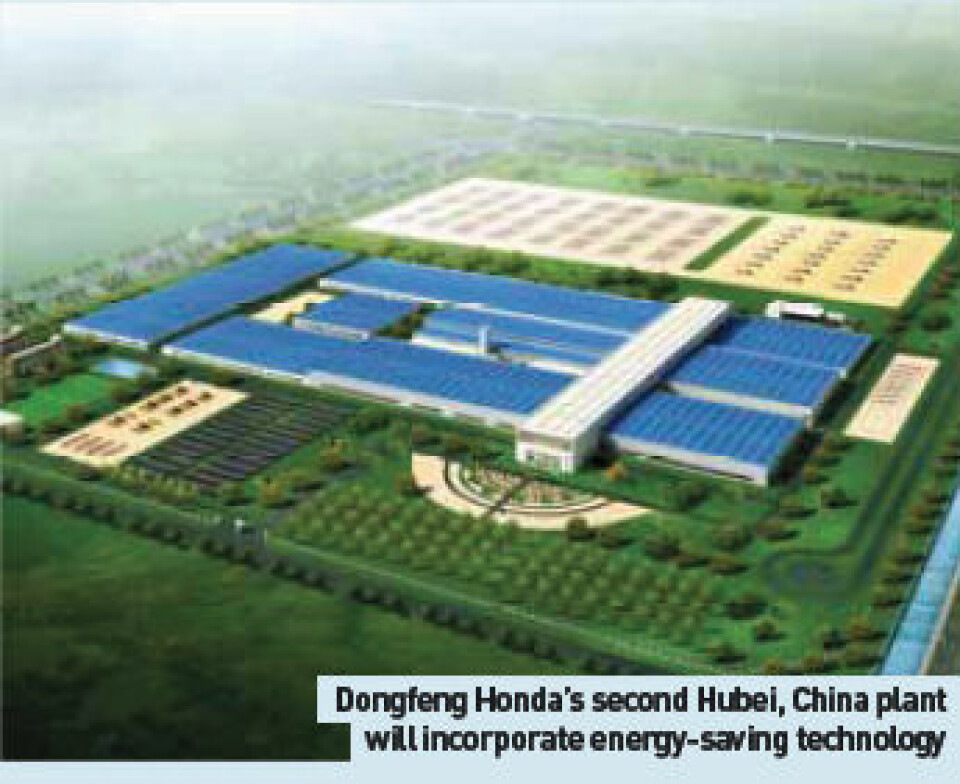Pushing boundaries at Ford India

While car sales in China have tended to grab the recent headlines, sales in India – and particularly small car sales - continue to increase at a break-neck pace, with market leader Maruti Suzuki posting record sales earlier in the year. Several major manufacturers have plans to construct more greenfield facilities in-country, but environmental concerns can prove insurmountable, particularly when building on or near farm land. Tata Motors, forced to abandon its original Nano factory in West Bengal, is a case in point.
In light of the potential problems with greenfield site selection in a country where there is fierce competition between manufacturing operations and subsistence farmers for what little available land remains, Ford of India has chosen to avoid the problem by taking the brownfield route and expanding an existing facility.

Ford, a small and as yet comparatively minor manufacturer in India, elected to invest $500m in its Maraimalai Nagar plant, located near Chennai, in order to double current capacity. As the first cars start to roll out of the plant, which has effectively doubled its size in terms of capacity, the carmaker believes that it will reap the rewards of an aggressive push into India’s small car segment. The Maraimalai Nagar complex, enlarged from 250 to 353 acres, is the company’s only production site for its new small car, the Figo. Following what Ford calls a ‘best of the best’ approach, the modernised complex has been benchmarked for quality and production efficiency against India’s volume leaders, Maruti-Suzuki, Hyundai and Tata Motors, as well as other major production plants around the world. “The story in Maraimalai Nagar is about much more than doubling our production capacity,” explains Tom Chackalackal, Vice-President, Manufacturing, Ford of India. “It’s about a mindset across the organization that’s absolutely committed to quality.”
plant facts
• Established in 1995, Ford India is a wholly-owned subsidiary of Ford Motor Company producing the Ikon, Fusion, Endeavour, Fiesta and Figo
• Ford Chennai directly employs 2,350 staff, technicians, engineers and craftspeople
• The average age of technical staff is 27 and 32 for managerial and administrative employees
• Office staff numbers have been increased 27% to approximately 760
• Technical staff have attained a minimum of 12th standard, or have received a diploma in engineering. Staff members typically have engineering or management degrees.
• Plant redevelopment further included construction of a zero-dis charge wastewater treatment facility serving the entire complex
• Expansion of the assembly plant facility was achieved in 21 months
Part delivery
In India, small vehicles make up approximately 70% of the new car market. Ford’s new five-door hatchback, derived from Ford of Europe’s previous-generation Fiesta, represents something of a revolution for the firm’s Indian division and particularly the Maraimalai Nagar plant. The launch of Figo in March this year, combined with anticipated market demand, is the underlying reason for the doubling of on-site manufacturing capacity to 200,000 units per annum (upa); without the Figo, the planned expansion would never have been put into action.
The plant is further served by a growing supplier park, feeding components and sub-assemblies in line with the Chennai facility’s push for lean manufacturing. The list of on-site suppliers continues to increase but already includes: Visteon, Tata Johnson Controls, YAPP and Cooper. Ford notes that 65% of the plant’s supply base is now located within 100km of the site.
Further, the manufacturing plant is now geared to receive an increased proportion of sequenced supplier-delivered assemblies using a conveyor system. Using this link, major components and modules such as instrument panels, wheeland- tyre units and front-end modules all take a lean journey to final assembly. Additionally, a selection of smaller parts is carried with each vehicle as it advances on the production line. Essentially a rolling trolley kitting system, the arrangement ensures ease of assembly for line workers, while reducing the chance for incorrect part installation.
In a production fi rst for both brands, SEAT’s Martorell plant, located in north-eastern Spain, has been chosen as the assembly site for the new Audi Q3 crossover. Keenly aware that Martorell had been suffering from underutilisation, VW Group elected to expand the SEAT facility instead of invest in a new greenfield site.
Construction at Martorell began in mid-2009 and was completed in February this year. Developed on a brownfi eld site, the new facility features almost 300 robots and, according to Audi, it will be one of the most modern workshops of its kind in the world. It will also be one of the most energy effi cient, with the new facility employing a system of skylights to take advantage of the area’s extended daylight hours. Savings associated with this single feature are estimated to be 250 megawatt hours per year.
At what the company refers to as Workshop Six, approximately 1,500 employees will start assembly of the Q3 in 2011. Audi states the crossover will play a role in achieving the company goal of 1.5 million vehicle sales per annum by the end of 2015, a projected 50% rise on 2009 fi gures. Total investment at Martorell for the Q3 project totals €300m, to date the largest investment made by the parent company in SEAT.
Workshop Six in figures:
Total surface area: 30,000m2
Bodywork facilities: 23,000m2
Maximum height: 14m
Number of roof skylights: 72 (1,152m2)
Signal interference
Another part of the plant upgrade at Maraimalai Nagar covers the facility’s multiple IT systems’ radio frequency identification (RFID) system, the technology having replaced labour-intensive part and logistics processes. These systems now help to manage reduced inventories across each area of vehicle production, with items stored closer to a given production area translating to increased production speeds. Supplier links are managed to ensure that where possible, part deliveries are made just-in-time and justin- sequence, deliveries meeting vehicles as they advance through assembly.
Thanks to the erection of two new buildings – respectively engine and machine shops - approximately 60% of the plant site is now built-up area. The remainder comprises lawns and an extensive green belt surrounding the facility.
Increased automation
Like many automotive production plants in India, Maraimalai Nagar was originally set up to use low-cost manual labour across the majority of manufacturing activities. Following the recent investment, the plant features considerably more automation, including a new stamping press line with automated crossbar technology, as well as a newly-flexible body shop capable of producing six different car bodies on a single line. In total, 92 robots of various types have been integrated into key areas of the vehicle build process, which according to Ford, has served to improve repeatability and overall finished vehicle quality. In all, Ford India states that 30% of production activities at the plant are now completed using automated processes.
“This is a huge conversion that brings together all the lessons we’ve learned in the Indian market, with best practices from Ford and our competitors,” says Tom Chackalackal. “It will make us very competitive with Indian manufacturers and gives Indian customers a better product than ever. Much of our investment is centred on quality and our desire to be the best in class.” Amongst the single most important additions to Ford’s Maraimalai Nagar facility is the new assembly line. At a stroke, the new line has raised the plant’s capacity from 14 to 34 vehicles per hour. A variety of newly-automated processes on the line have been used to achieve this production increase.
Workstations at Maraimalai Nagar now feature a variety of error-proofing processes. Using a red light-green light system, tools alert the operator as to whether a given task has been performed correctly. One example is the fitting of door seals, where a job-specific seal gap measuring gauge is used to check seal installation. This prevents any problems that could affect door alignment and closure.

Similar tools are used in fastening applications. When a bolt is tightened to the correct torque, positive feedback is given to the operator. Ford insists that this extra step in the assembly process is essential, as it too is designed to eliminate build inconsistency and prevent any resulting quality issues.
While the chassis line has been set up for flexible assembly, this has only been possible through the use of a centralized bulk material feeder and engine delivery via overhead conveyors. Additionally, new levels of lean manufacturing have been achieved with the new IT systems; where the plant previously held a 60-day supply of coil steel, the system has allowed that to be slashed to only two days of stock.
A better body shop
The plant’s existing semi-automated single press line, supplied by Schuler, has been augmented with the addition of a new Komatsu press line, capable of producing 15 parts per minute and having die change times of under three minutes. There is also a new Fagor tryout press, as well as a special robot crane with four-die stacking capability (up from the previous two-die stacking). Ford claims a two-day reduction in the stamping cycle for production of sheet metal components.
In the bodyshop, the new single-line flow process includes an automated underbody and flexible framing line. The need for precision is naturally of paramount importance, as each large metal structure is positioned and spot-welded to a vehicle floorpan. Ford says bodyshop automation has increased by 30%, largely due to the installation of 66 new robots carrying out critical processes such as spot welding, sealer application and door hemming.
To further improve quality, new welding robots are equipped with servo motor welding guns. Notably quieter than previous welding-gun technology, they also deliver reduced expulsion and burring, with the servo motors allowing the welding tips to be brought smoothly into place, helping to eliminate distortion of the metal and ensuring stable weld pressure.

Pioneering paint shop technology
Maraimalai Nagar is the first global Ford car plant - and the first in India - to introduce the three-wet, high-solids paint process. Ford pioneered the technology at its Avon Lake light truck plant in the US. In India, it has partnered with BASF, PPG and facility supplier Dürr for the project. The three-wet, high-solids process is claimed to deliver a superior finish, with improved depth of colour, higher gloss finish and better resistance against scratching and chipping. Hydraulic pumps have replaced pneumatic pumps used in preparation and delivery of the various paint colours. The new paint line offers a choice of 11 exterior colours at any given time, where the old system had a maximum of eight colour choices.
Robots in the newly-automated paint booths apply three coats - primer, base and clear coat – each added, as the system name implies, while the previous coat is still wet. The main advantage of the process is elimination of the need to flash off car bodies between coats. As such, Ford has been able to raise paint shop capacity from 15 to 34 vehicles per hour. The new paint booth uses 16 robots: eight for the base coat application and four each for the primer and clear coat. The new system also incorporates an automated underbody sealer application process. Using three robots, it can apply sealer more quickly and at a higher quality level, which translates to extended vehicle lifetime. After the finishes are applied, each vehicle then passes through one of two new baking ovens.
The environmental footprint of the paintshop is also said to be greatly reduced, thanks largely to the threewet technology. According to Ford, there are fewer CO2 emissions, while emissions of VOCs have been reduced by as much as 20% in comparison to medium-solids, solventborne paint operations.
“The biggest user of energy and fuel in a manufacturing plant is the paint shop,” states Chackalackal. “By introducing this new technology, we’re significantly cutting energy use and fuel consumption, and that’s good for the environment and the community.”

All in one place
While expanding the production capacity of its Chennai plant, Ford has also added a new 3.2km test track to the Maraimalai Nagar complex. Although the company considered building the track on a greenfield site, the track was eventually constructed on the plant’s newlyincorporated 103 acres of land.
The new track comprises various road surfaces, each designed to simulate real-world driving conditions. According to Ford, vehicles are typically driven over 40km on the circuit, where vehicles had previously been tested on public roads surrounding the plant.
Immediately after final assembly, and in line with best practice benchmarks set by Ford plants around the world, a squeak-and-rattle test is used to check both vehicle quality and structural strength before being shipped. This, says Ford, is especially important for the new Figo, which unlike most Ford India products will be exported to other regional markets.
The track’s facilities also include a new four-post test device, designed to simulate a variety of vehicle load conditions. Used to verify the robustness of a vehicle’s chassis, it also assists in isolating the causes of squeaks and rattles, which can then be addressed by the part supplier or on the production line.
The squeak-and-rattle test is followed by an underbody hot check, used to ensure engine oil, transmission oil, engine coolant and air-conditioning systems are leak-free when the vehicle is at full operating temperature. A final check on the air-conditioning system includes a temperature check of the grille as an extra quality measure.
A test bed for water wading capability is another part of the expanded complex. While this is used to validate Ford’s own standards, it is a vital capability in a country where roads can be prone to flash flooding in monsoon season. The test involves driving the vehicle at a speed of 10 km/h through tank of water 450mm deep and 50 metres long. Each vehicle is then thoroughly examined to ensure there are no leaks or mechanical malfunctions.
Emphasizing the importance of building leak-proof cars, in-line water testing also takes place during the vehicle assembly process. This is meant to ensure that every car is free from water ingress even before it reaches the test-track’s tank and that all weather seals and closures are correctly installed.
Preparing for exports
Ford’s Chennai manufacturing facility is now wellpositioned to lead the company’s regional small-car engineering and production operations, according to Ford’s Executive Vice-President, Asia Pacific and Africa, John Parker.
“India’s long-term significance in our strategy for this region is readily evident with the completion of this new plant,” Parker states. “We’ve committed in total more than $950 million in recent years to make India one of Ford’s strategic production hubs. It’s a strategy built on creating great products whose appeal will reach beyond India’s borders, and it’s fully in line with our business objective to create volume production centres of excellence in this region.”
The Chennai plant is now preparing for its next stage of expansion. This includes plans to manufacture diesel and petrol engines for local vehicle production and for export within Ford’s Asia Pacific and Africa region.


